Aquatic Weed for Concrete Sustainability
Abstract
1. Introduction
2. Materials and Methods
2.1. Materials Used
2.1.1. Binders
2.1.2. Coarse Aggregates
2.1.3. Fine Aggregates
2.1.4. Water Hyacinth
2.2. Mix Proportions and Sample Preparation
2.3. Test Methods
3. Results and Discussion
3.1. Fresh Properties of WHA
3.2. Water Absorption Capacity
3.3. Compressive Strength Development
3.4. Thermogravimetric Analysis
3.5. Fourier Transformed Infrared Spectroscopy Analysis
3.6. Sulphate Attack Resistance
4. Conclusions
- Burning water hyacinth at 800 °C for 6 h yields a good pozzolanic property, suitable for use as a supplementary cementitious material in concrete.
- The slump values of concrete are highly dependent on the proportion of WHA. High levels of WHA increase slump results and, hence, the workability of the concrete mix.
- The concrete specimens exhibited a reduction in water absorption with curing time, which can be attributed to the minimal voids and pores in the concrete samples.
- The concrete specimens with the highest percentage of WHA exhibited the greatest durability.
- Adding 5% to 10% WHA to concrete improves its compressive strength. However, further increasing the WHA replacement level results in a decrease in the compressive strength of the concrete, with a 10% replacement of cement with WHA yielding the optimal results.
- A microstructure analysis confirmed that the structure of C–S–H gels changes in samples when WHA is added, which contributes to compressive strength. The decomposition of Ca(OH)2 and the formation of CaO, as well as the release of H2O, reduce the porosity of concrete.
- Replacing OPC with WHA in concrete by up to 10% would improve the sulfate attack resistance of the concrete.
- Further research is recommended to improve the use of WHA in concrete on a large scale in order to achieve greater sustainability without adverse environmental and socioeconomic impacts.
Author Contributions
Funding
Institutional Review Board Statement
Informed Consent Statement
Data Availability Statement
Conflicts of Interest
References
- Krishnan, S.; Murugesh, V. Experimental Study on Strength of Water Hyacinth Ash As Partial Replacement of Cement in Concrete. Int. J. Res. Appl. Sci. Eng. Technol. 2018, 9, 93–96. [Google Scholar]
- Divyah, N.; Thenmozhi, R.; Neelamegam, M.; Prakash, R. Characterization and behavior of basalt fiber-reinforced lightweight concrete. Struct. Concr. 2019, 22, 422–430. [Google Scholar] [CrossRef]
- Prakash, R.; Thenmozhi, R.; Raman, S.N. Mechanical characterisation and flexural performance of eco-friendly concrete produced with fly ash as cement replacement and coconut shell coarse aggregate. Int. J. Environ. Sustain. Dev. 2019, 18, 131–148. [Google Scholar] [CrossRef]
- Prakash, R.; Raman, S.N.; Subramanian, C.; Divyah, N. Eco-friendly fiber-reinforced concretes. In Handbook of Sustainable Concrete and Industrial Waste Management; Woodhead Publishing: Sawston, UK, 2022; pp. 109–145. [Google Scholar] [CrossRef]
- Srividhya, M.N.; Vidjeapriya, S.R. Enhancing the performance of hyposludge concrete beams using basalt fiber and latex under cyclic loading. Comput. Concr. 2021, 28, 93–105. [Google Scholar] [CrossRef]
- Balasundaram, N.; Murugesh, V. Experimental behaviour of water hyacinth ash as partial replacement of cement on short column. Int. J. Recent Technol. Eng. 2019, 7, 648–650. [Google Scholar]
- Damtoft, J.S.; Lukasik, J.; Herfort, D.; Sorrentino, D.; Gartner, E.M. Sustainable development and climate change initiatives. Cem. Concr. Res. 2008, 38, 115–127. [Google Scholar] [CrossRef]
- El-Gamal, S.; El-Hosiny, F.; Amin, M.; Sayed, D. Ceramic waste as an efficient material for enhancing the fire resistance and mechanical properties of hardened Portland cement pastes. Constr. Build. Mater. 2017, 154, 1062–1078. [Google Scholar] [CrossRef]
- Ilki, A.; Kumbasar, N. Behavior of damaged and undamaged concrete strengthened by carbon fiber composite sheets. Struct. Eng. Mech. 2002, 13, 75–90. [Google Scholar] [CrossRef]
- Prakash, R.; Thenmozhi, R.; Raman, S.N.; Subramanian, C. Characterization of eco-friendly steel fiber-reinforced concrete containing waste coconut shell as coarse aggregates and fly ash as partial cement replacement. Struct. Concr. 2019, 21, 437–447. [Google Scholar] [CrossRef]
- Prakash, R.; Thenmozhi, R.; Sudharshan, N.R.; Subramanian, C. Mechanical behaviour of polypropylene fibre reinforced concrete containing waste coconut shell as coarse aggregates and fly ash as partial cement replacement. Rev. Fac. Ing. Univ. Antioq. 2019, 94, 33–42. [Google Scholar] [CrossRef]
- Prakash, R.; Divyah, N.; Srividhya, S.; Avudaiappan, S.; Amran, M.; Raman, S.N.; Guindos, P.; Vatin, N.I.; Fediuk, R. Effect of Steel Fiber on the Strength and Flexural Characteristics of Coconut Shell Concrete Partially Blended with Fly Ash. Materials 2022, 15, 4272. [Google Scholar] [CrossRef]
- Torres, M.; Rodríguez-Puertas, C.; Alonso, M.; Puertas, F. Alkali activated slag cements using waste glass as alternative activators. Rheol. Behav. 2015, 54, 45–57. [Google Scholar] [CrossRef]
- Huntzinger, D.N.; Eatmon, T.D. A life-cycle assessment of Portland cement manufacturing: Comparing the traditional process with alternative technologies. J. Clean. Prod. 2009, 17, 668–675. [Google Scholar] [CrossRef]
- Vieira, D.R.; Calmon, J.L.; Coelho, F.Z. Life cycle assessment (LCA) applied to the manufacturing of common and ecological concrete: A review. Constr. Build. Mater. 2016, 124, 656–666. [Google Scholar] [CrossRef]
- Turner, L.K.; Collins, F.G. Carbon dioxide equivalent (CO2-e) emissions: A comparison between geopolymer and OPC cement concrete. Constr. Build. Mater. 2013, 43, 125–130. [Google Scholar] [CrossRef]
- Puertas, F.; García-Díaz, I.; Barba, A.; Gazulla, M.; Palacios, M.; Gómez, M.; Martínez-Ramírez, S. Ceramic wastes as alternative raw materials for Portland cement clinker production. Cem. Concr. Compos. 2008, 30, 798–805. [Google Scholar] [CrossRef]
- Prakash, R.; Thenmozhi, R.; Raman, S.N.; Subramanian, C.; Divyah, N. Mechanical characterisation of sustainable fibre-reinforced lightweight concrete incorporating waste coconut shell as coarse aggregate and sisal fibre. Int. J. Environ. Sci. Technol. 2020, 18, 1579–1590. [Google Scholar] [CrossRef]
- Prakash, R.; Raman, S.N.; Divyah, N.; Subramanian, C.; Vijayaprabha, C.; Praveenkumar, S. Fresh and mechanical characteristics of roselle fibre reinforced self-compacting concrete incorporating fly ash and metakaolin. Constr. Build. Mater. 2021, 290, 123209. [Google Scholar] [CrossRef]
- Ingwani, E.; Gumbo, T.; Gondo, T. The general information about the impact of water hyacinth on Aba Samuel Dam, Addis Ababa, Ethiopia: Implications for ecohydrologists. Ecohydrol. Hydrobiol. 2010, 10, 341–345. [Google Scholar] [CrossRef]
- Murugesh, V. Experimental investigation on water hyacinth ash as the partial replacement of cement in concrete. Int. J. Civ. Eng. Technol. 2017, 8, 1013–1018. [Google Scholar]
- Dinesh, M.V. Experimental Behavior of Water Hyacinth Ash as the Partial Replacement of Cement in Concrete. Int. J. Sci. Res. Sci. Eng. Technol. 2017, 3, 244–248. [Google Scholar]
- Navarro, L.; George, P. Water Hyacinth in Africa and the Middle East: A survey of Problems and Solutions. 2000, p. 130. Available online: http://books.google.com/books?hl=es&lr=&id=hhXqXNQ0WSQC&pgis=1 (accessed on 13 March 2022).
- IBC. Ecosystems of Ethiopia; Institute of Biodiversity and Conservation: Addis Ababa, Ethiopia, 2011. [Google Scholar]
- Dechassa, N. Current Status of Water Hyacinth (Eichhornia crassipes) in Ethiopia: Achievements, Challenges and Prospects: A Review. J. Environ. Earth Sci. 2020, 10, 36–47. [Google Scholar] [CrossRef]
- Gizaw, E.; Legesse, W.; Haddis, A.; Deboch, B. Assessment of factors contributing to eutrophication of Aba Samuel water reservior in Addis Ababa, Ethiopia. Ethiop. J. Health Sci. 2002, 14, 109–113. [Google Scholar]
- Stroud, A. Water hyacinth (Eichhornia crassipes [Mart.] Solms) in Ethiopia. In Proceedings of the 9th Annual Conference of the Ethiopian Weed Science Committee, Addis Abeba, Ethiopia, 9–10 April 1991; EWSC: Addis Abeba, Ethiopia, 1994. [Google Scholar]
- Zewdie, O.; Lemma, K.; Nikus, Y. Prosopis juliflora: Potentials and problems. AREM. 2005. Available online: https://agris.fao.org/agris-search/search.do?recordID=ET2006000002 (accessed on 13 March 2022).
- Zelalem, W.; Kifle, D.; Mengistu, S.; Wondie, A. Weed-bed Macro-invertebrate Composition and Abundance in Relation to Water Hyacinth (Eichhornia crassipes (Mart) Solms) in the North-Eastern. J. Agric. Environ. Sci. 2017, 2, 50–64. [Google Scholar]
- Firehun, Y.; Struik, P.C.; Lantinga, E.A.; Taye, T. Joint use of insects and fungal pathogens in the management of water hyacinth (Eichhornia crassipes): Perspectives for Ethiopia. J. Aquat. Plant Manag. 2013, 51, 109–121. [Google Scholar]
- Yirefu, F.; Yirefu, F.; Struik, P.; Struik, P.; Lantinga, E.; Lantinga, E.; Tessema, T.; Tessema, T. Occurrence and diversity of fungal pathogens associated with water hyacinth and their potential as biocontrol agents in the Rift Valley of Ethiopia. Int. J. Pest Manag. 2017, 63, 355–363. [Google Scholar] [CrossRef]
- Tegene, S.; Ayele, N. Prevalence and Intensity of Water Hyacinth Infestation in the Water Bodies of Rift Valley, Ethiopia. J. Agric. Nat. Resour. Sci. 2014, 1, 118–126. [Google Scholar]
- Dersseh, M.G.; Kibret, A.A.; Tilahun, S.A.; Worqlul, A.W.; Moges, M.A.; Dagnew, D.C.; Abebe, W.B.; Melesse, A.M. Potential of Water Hyacinth Infestation on Lake Tana, Ethiopia: A Prediction Using a GIS-Based Multi-Criteria Technique. Water 2019, 11, 1921. [Google Scholar] [CrossRef]
- ASTM C1084; Standard Test Method for Portland-Cement Content of Hardened Hydraulic-Cement. ASTM: West Conshohocken, PA, USA, 2015; Volume i, pp. 315–319. [CrossRef]
- Time, I.S. ASTM C150-12 Common Reference Type I Portland Cement for Use in ASTM C989-12 Slag Activity Testing. 2012. Available online: http://www.ccrl.us/ (accessed on 13 March 2022).
- American Concrete Institute. Standard Practice for Selecting Proportions for Normal, Heavyweight, and Mass Concrete; American Concrete Institute: Farmington Hills, MI, USA, 1991; pp. 1–38. [Google Scholar]
- ASTM C143/C143M; Standard Test Method for Slump of Hydraulic-Cement Concrete. ASTM: West Conshohocken, PA, USA, 2015; pp. 1–4. [CrossRef]
- ASTM C 642-06; Standard Test Method for Density, Absorption, and Voids in Hardened Concrete. ASTM International, United States. Annu. B. ASTM Stand.: West Conshohocken, PA, USA, 1997; pp. 1–3.
- ASTM C109/C109M-02; Standard Test Method for Compressive Strength of Hydraulic Cement Mortars. Annu. B. ASTM Stand.: West Conshohocken, PA, USA, 2020; Volume 4, p. 9.
- ASTM. Standard Specification for Ferromolybdenum. Current 2000, 89, 6–7. [Google Scholar] [CrossRef]
- Hwang, C.-L.; Yehualaw, M.D.; Vo, D.-H.; Huynh, T.-P. Development of high-strength alkali-activated pastes containing high volumes of waste brick and ceramic powders. Constr. Build. Mater. 2019, 218, 519–529. [Google Scholar] [CrossRef]
- Vo, D.-H.; Hwang, C.-L.; Thi, K.-D.T.; Yehualaw, M.D.; Chen, W.-C. Effect of Fly Ash and Reactive MgO on the Engineering Properties and Durability of High-Performance Concrete Produced with Alkali-Activated Slag and Recycled Aggregate. J. Mater. Civ. Eng. 2020, 32, 04020332. [Google Scholar] [CrossRef]
- Frías, M.; Savastano, H.; Villar, E.; de Rojas, M.I.S.; Santos, S. Characterization and properties of blended cement matrices containing activated bamboo leaf wastes. Cem. Concr. Compos. 2012, 34, 1019–1023. [Google Scholar] [CrossRef]
- Yehualaw, M.D.; Hwang, C.-L.; Vo, D.-H.; Koyenga, A. Effect of alkali activator concentration on waste brick powder-based ecofriendly mortar cured at ambient temperature. J. Mater. Cycles Waste Manag. 2021, 23, 727–740. [Google Scholar] [CrossRef]
- Hwang, C.-L.; Yehualaw, M.D.; Vo, D.-H.; Huynh, T.-P.; Largo, A. Performance evaluation of alkali activated mortar containing high volume of waste brick powder blended with ground granulated blast furnace slag cured at ambient temperature. Constr. Build. Mater. 2019, 223, 657–667. [Google Scholar] [CrossRef]
- Shah, V.; Scott, A. Hydration and microstructural characteristics of MgO in the presence of metakaolin and silica fume. Cem. Concr. Compos. 2021, 121, 104068. [Google Scholar] [CrossRef]
- Balagam, S.R.K. Thermogravimetric Analysis of Concrete. IJMTER 2018, 4, 5. [Google Scholar]
- Krishnan, E.; Solaiyan, V. Study on engineering and microstructural properties of ambient cured GP concrete produce from GGBS and M-sand. J. Crit. Rev. 2020, 7, 499–506. [Google Scholar]
- Zhang, S.P.; Zong, L. Evaluation of Relationship between Water Absorption and Durability of Concrete Materials. Adv. Mater. Sci. Eng. 2014, 2014, 650373. [Google Scholar] [CrossRef]
- Nie, Q.; Zhou, C.; Shu, X.; He, Q.; Huang, B. Chemical, Mechanical, and Durability Properties of Concrete with Local Mineral Admixtures under Sulfate Environment in Northwest China. Materials 2014, 7, 3772–3785. [Google Scholar] [CrossRef]
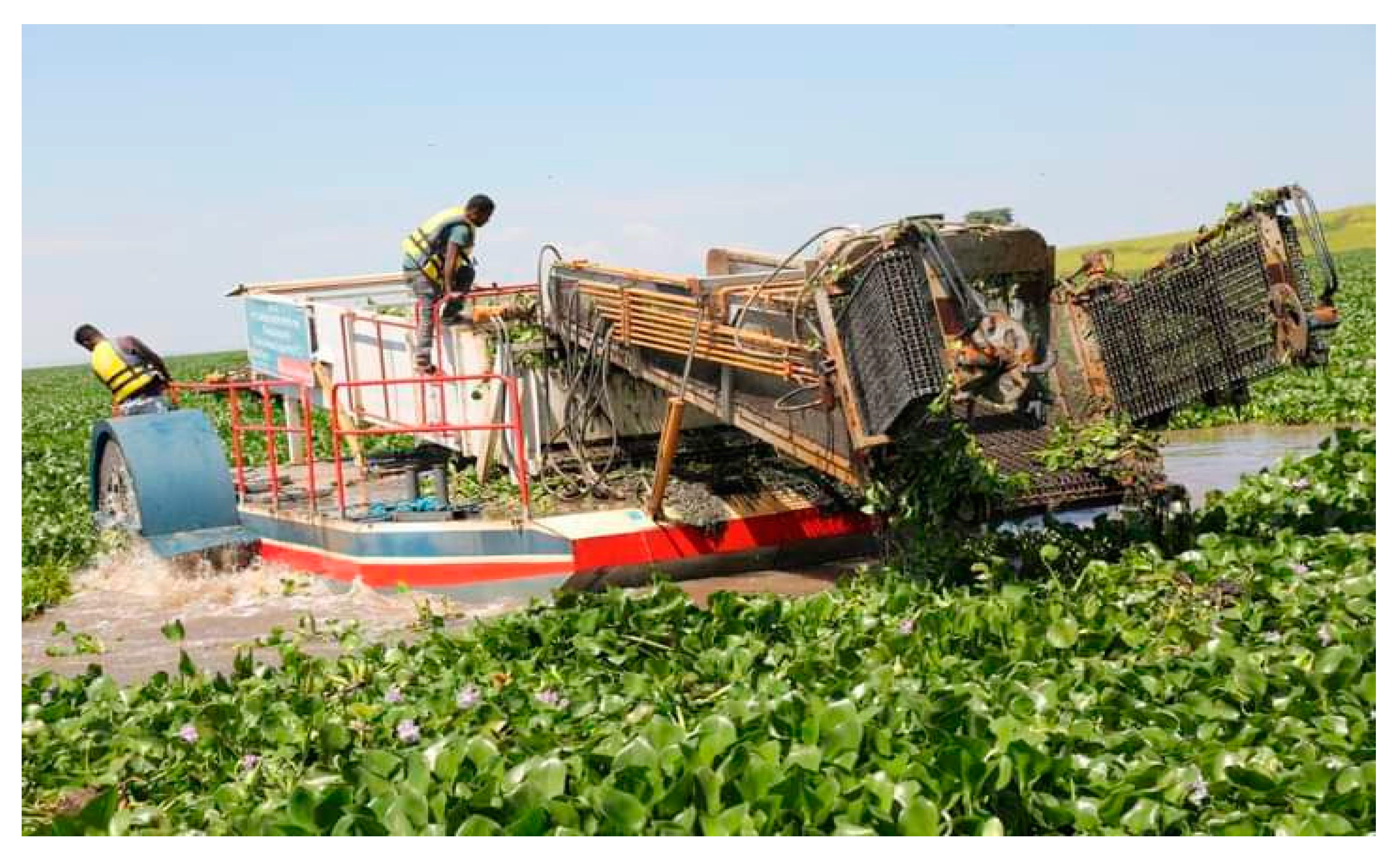
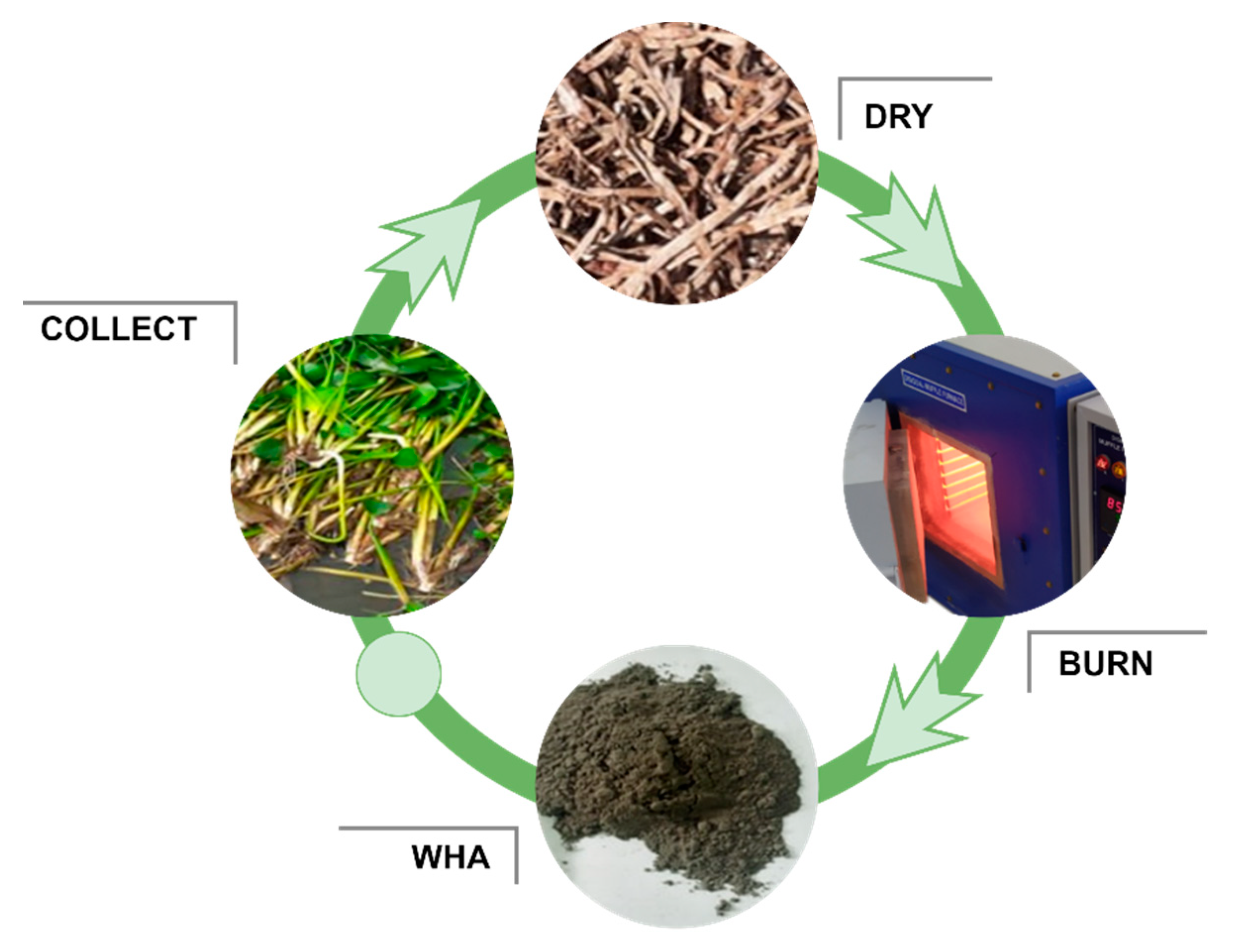
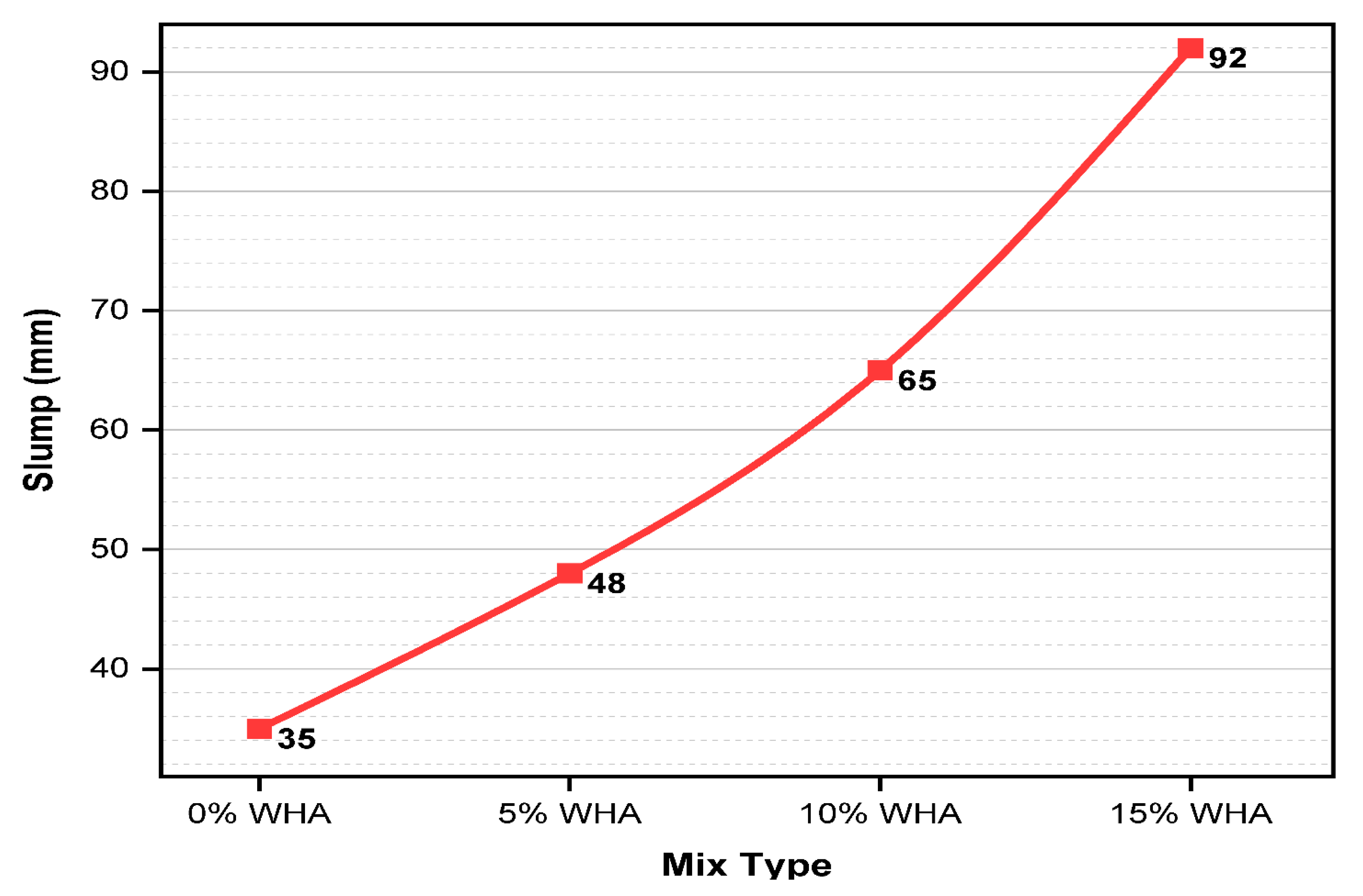

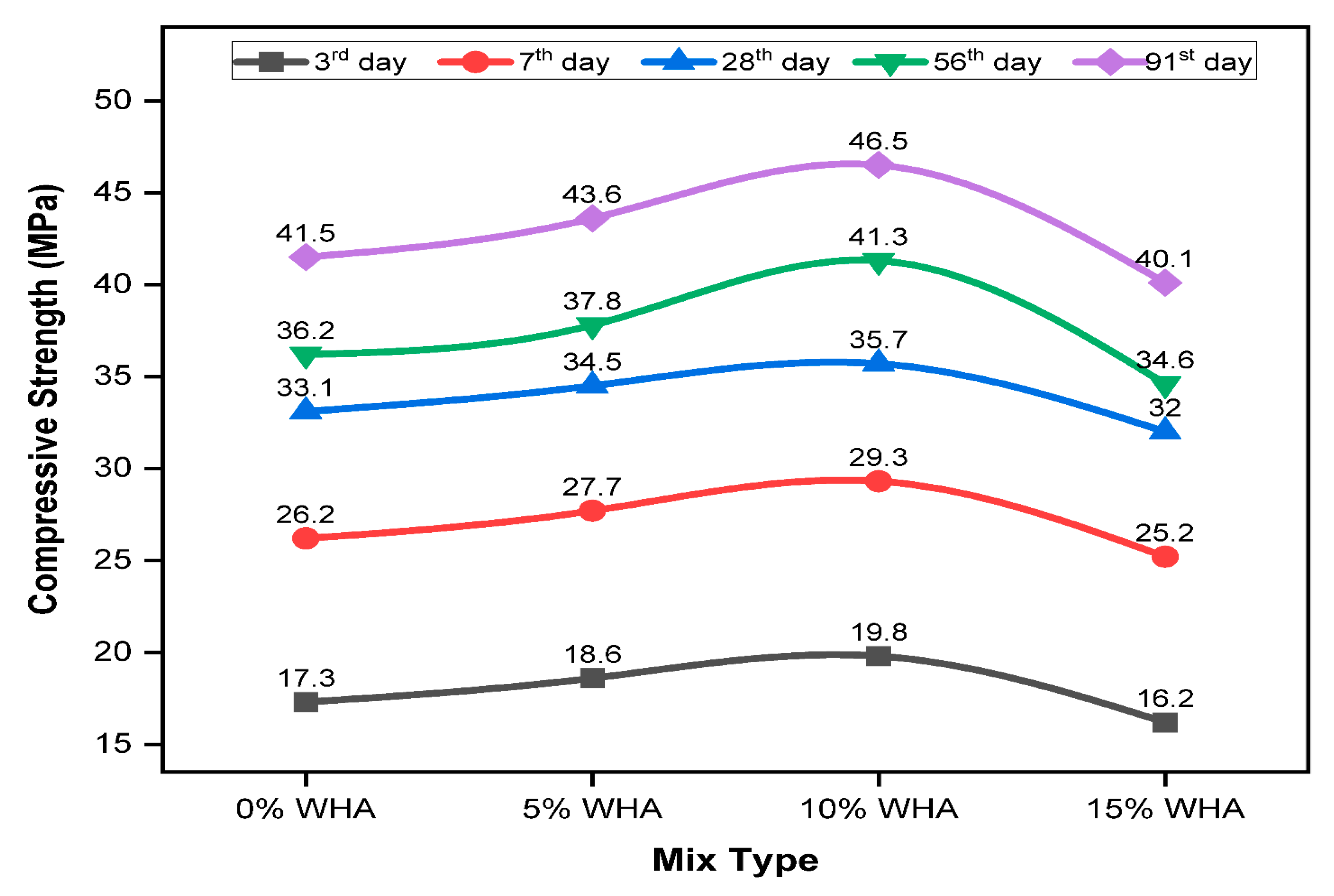

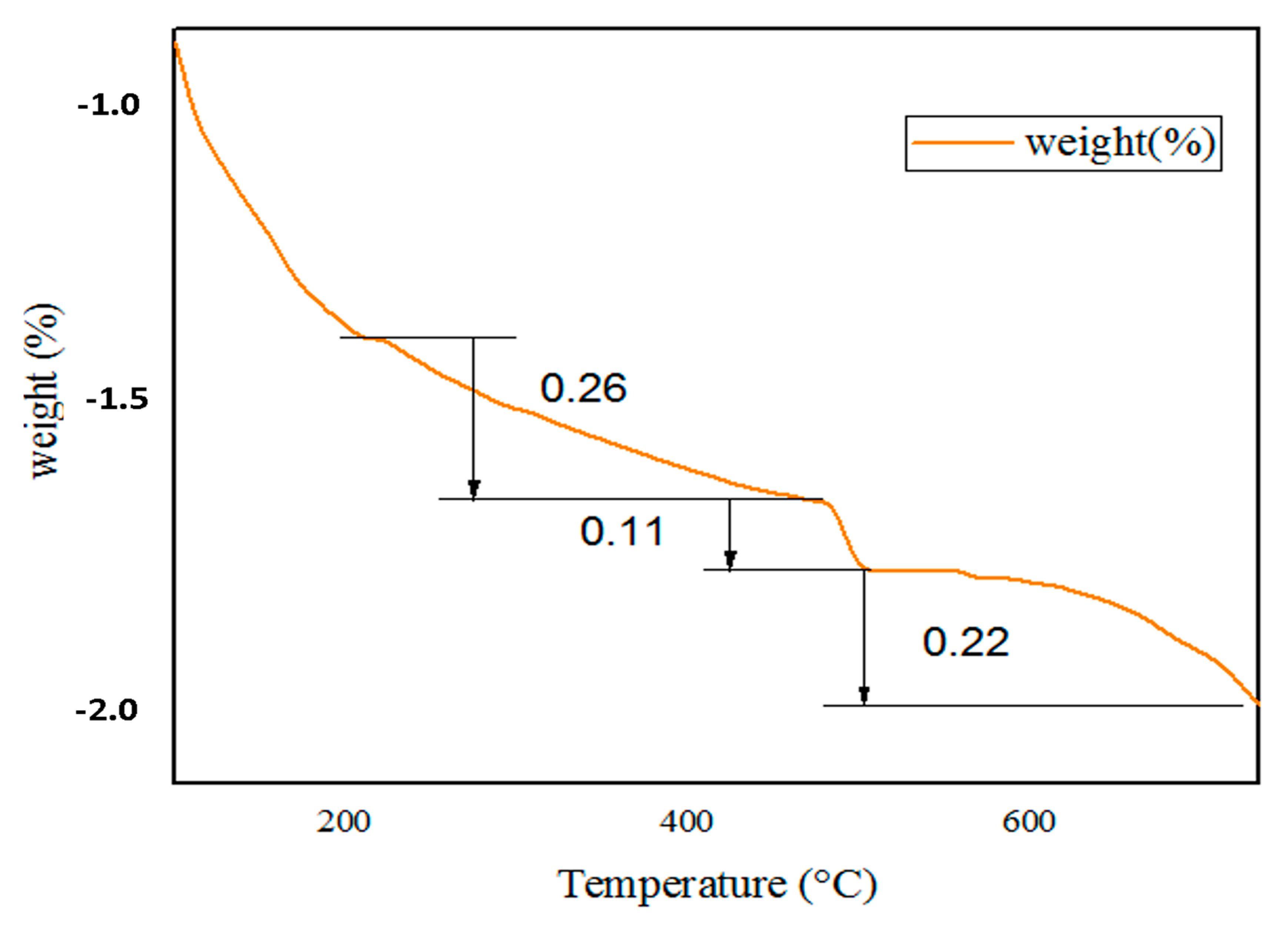


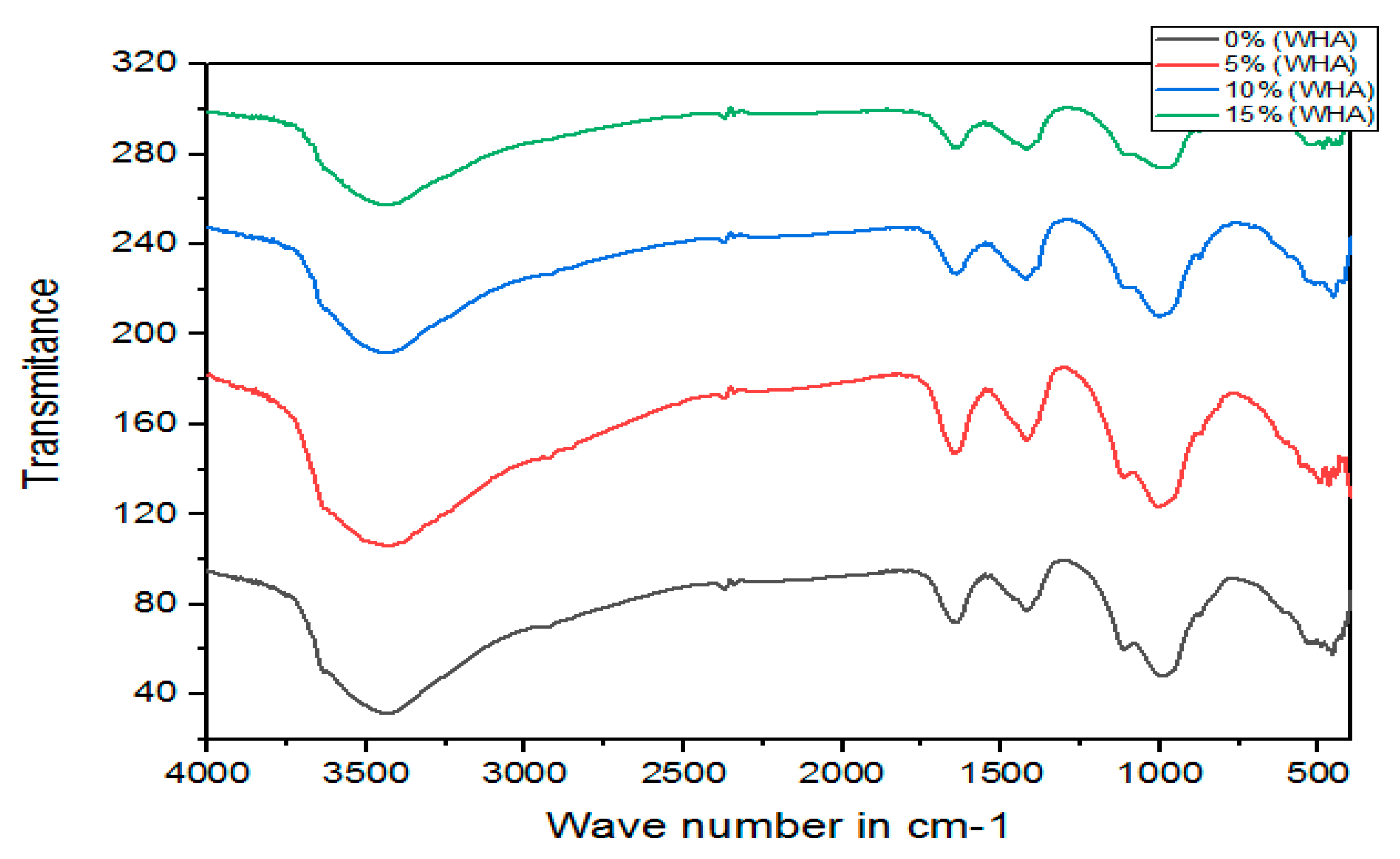
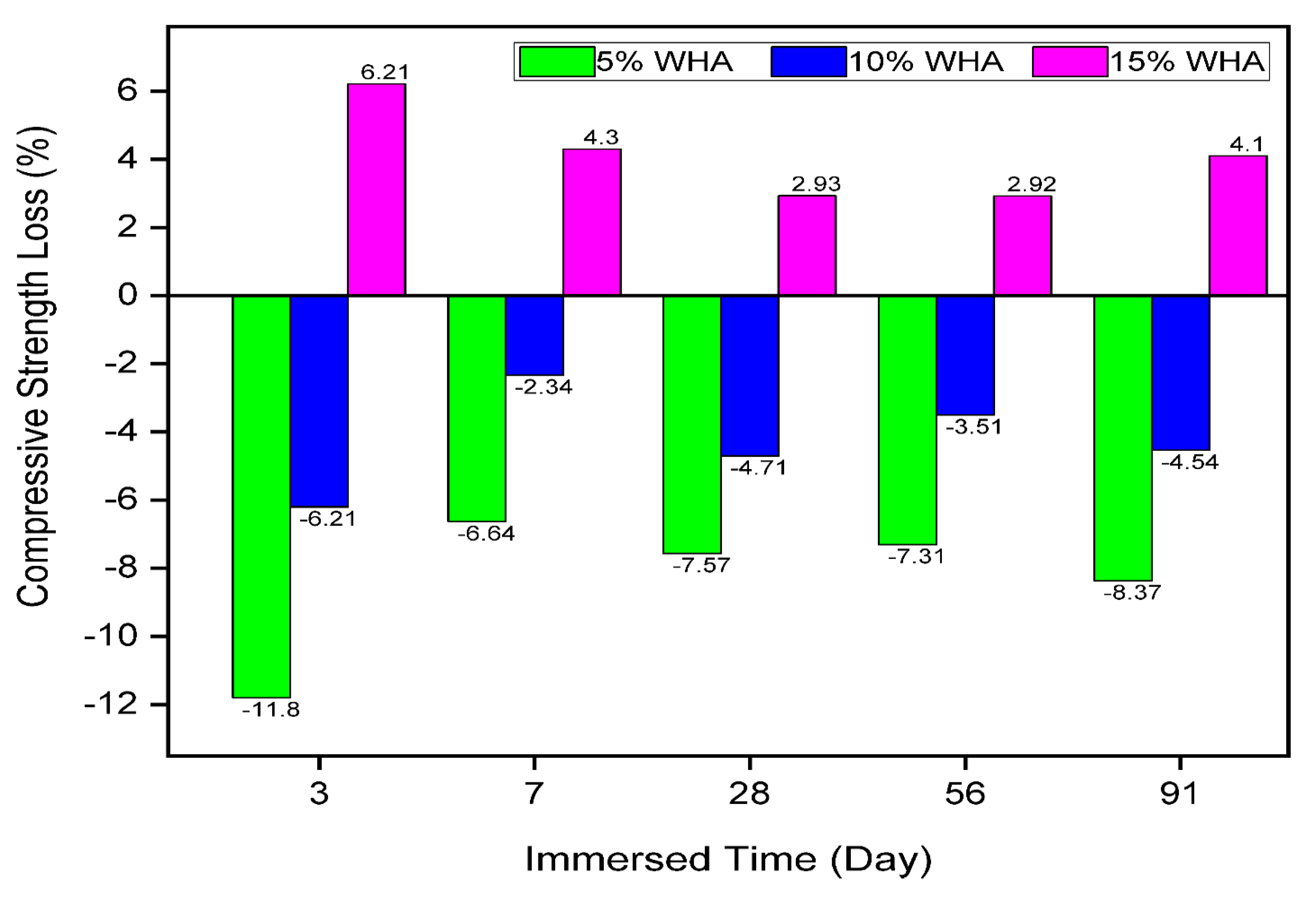
| No. | Property | Test Method | Result | Unit |
|---|---|---|---|---|
| 1 | Unit weight | ASTM C 29 | 1594.56 | kg/m3 |
| 3 | Specific gravity | ASTM C 128 | 2.75 | - |
| 4 | Moisture content | ASTM C128 | 1.01 | % |
| 5 | Water absorption capacity | ASTM C128 | 1.41 | % |
| 6 | Nominal aggregate size | - | 25 | mm |
| No. | Property | Test Method | Result | Unit |
|---|---|---|---|---|
| 1 | Fineness modulus | ASTM C117 | 2.68 | - |
| 2 | Specific gravity | ASTM C 136 | 2.71 | - |
| 3 | Moisture content | ASTM C 128 | 1.8 | % |
| 4 | Water absorption capacity | ASTM C128 | 2.45 | % |
| No. | Mix Designation | Percentage of Cement | Percentage of WHA |
|---|---|---|---|
| 1 | 0% WHA | 100 | 0 |
| 2 | 5% WHA | 95 | 5 |
| 3 | 10% WHA | 90 | 10 |
| 4 | 15% WHA | 85 | 15 |
Publisher’s Note: MDPI stays neutral with regard to jurisdictional claims in published maps and institutional affiliations. |
© 2022 by the authors. Licensee MDPI, Basel, Switzerland. This article is an open access article distributed under the terms and conditions of the Creative Commons Attribution (CC BY) license (https://creativecommons.org/licenses/by/4.0/).
Share and Cite
Yehualaw, M.D.; Alemu, M.; Hailemariam, B.Z.; Vo, D.-H.; Taffese, W.Z. Aquatic Weed for Concrete Sustainability. Sustainability 2022, 14, 15501. https://doi.org/10.3390/su142315501
Yehualaw MD, Alemu M, Hailemariam BZ, Vo D-H, Taffese WZ. Aquatic Weed for Concrete Sustainability. Sustainability. 2022; 14(23):15501. https://doi.org/10.3390/su142315501
Chicago/Turabian StyleYehualaw, Mitiku Damtie, Mihiret Alemu, Behailu Zerihun Hailemariam, Duy-Hai Vo, and Woubishet Zewdu Taffese. 2022. "Aquatic Weed for Concrete Sustainability" Sustainability 14, no. 23: 15501. https://doi.org/10.3390/su142315501
APA StyleYehualaw, M. D., Alemu, M., Hailemariam, B. Z., Vo, D.-H., & Taffese, W. Z. (2022). Aquatic Weed for Concrete Sustainability. Sustainability, 14(23), 15501. https://doi.org/10.3390/su142315501








